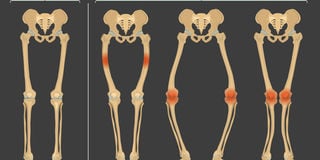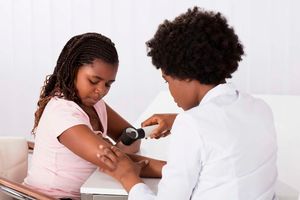Rickets: How to identify and prevent your child from getting it

What you need to know:
- Rickets is a bone disorder that has been around for centuries and primarily affects young children. The good news is that rickets is preventable and treatable.
- Among the risk factors for rickets is exclusive breastfeeding.
- Rickets can be prevented through diet and supplements, and reversed via surgery.
If you are a parent, there is a good chance you have heard of rickets. However, would you imagine it striking your child?
Rickets is a disease that has been around for centuries and primarily affects young children. The good news is that rickets is preventable and treatable.
Rickets is a skeletal disorder that causes the softening and weakening of bones in children. This condition is primarily driven by a lack of vitamin D, essential for calcium absorption.
Rickets can also be caused by a lack of phosphorus and calcium in the diet or by liver and kidney disorders that prevent the body from properly using vitamin D.
In adults, osteomalacia (softening of bones) is a common condition caused by vitamin D deficiency.
Causes of rickets in children
Limited exposure to sunlight:
Children who spend most of their time indoors may not get enough vitamin D from sunlight.
Poor diet:
A diet that does not include foods that are rich in vitamin D and calcium can lead to rickets. Foods that are high in vitamin D include fatty fish such as salmon, tuna, mackerel, egg yolk, fortified milk, cereal, and orange juice.
Liver or kidney disorders:
Certain liver and kidney disorders can prevent the body from converting vitamin D into its active form.
Medications:
Some medications, such as anticonvulsants and glucocorticoids, can interfere with the body’s ability to absorb or use vitamin D.
What are the symptoms of rickets?
There are many signs and symptoms of rickets. Some of the most common include:
1. Poor growth and development, including a failure to reach typical height milestones
2. Bone pain, especially in the legs and spine
3. Muscle weakness
4. Legs appear curved
5. Protruding abdomen or forehead
6. Fractures
7. Rickets can also cause dental problems
8. Oddly shaped breastbone and ribcage
What increases the likelihood of developing rickets?
Age
Rickets can happen to children of any age, but it is more likely to occur in young children. Their bones are still growing, so they need vitamin D, calcium and phosphorus to help them grow strong.
Dark skin
People with dark skin are more likely to develop rickets because they have less vitamin D in their skin. This is because melanin, the pigment that gives skin its color, blocks the body's ability to absorb vitamin D from sunlight.
Exclusive breastfeeding
Babies who are exclusively breastfed are also at a higher risk of developing rickets. This is because breast milk does not contain enough vitamin D to meet the needs of a growing baby.
Diet
A diet that is low in calcium, phosphorus, and vitamin D can also lead to rickets. This is especially true if a child does not eat foods that are rich in these nutrients or if they do not get enough sunlight.
Family history
Some genes are linked to a higher risk of developing rickets. This means that if someone in your family has rickets, you may be more likely to develop it as well.
Premature birth
Babies who are born prematurely are also at a higher risk of developing rickets. This is because they may not have had enough time in the womb to build up their stores of vitamin D, calcium, and phosphorus.
Mother's deficiency
If a mother is deficient in vitamin D, calcium, or phosphorus during pregnancy, her baby may be born with rickets. This is because these nutrients are essential for the development of strong bones.
What are the potential complications of rickets?
If left untreated, rickets can lead to a number of complications. These include:
- Bone deformities
- Seizures
- Heart failure
- Prolonged disability
- Dental problems
- Delayed growth and development
How can you prevent rickets?
The best way to prevent rickets is to make sure that you and your children get enough vitamin D, calcium, and phosphorus. This can be done by:
- Spending time outside in the sun: Exposure to sunlight is the best way to get vitamin D. Just make sure to use sunscreen with an SPF of at least 15 to protect your skin from harmful UV rays.
- Eating a balanced diet: A diet that includes foods such as fatty fish, fortified milk, and eggs can help ensure that you are getting enough vitamin D.
- Taking supplements: If you are unable to get enough vitamin D from sunlight and food, you may need to take a supplement. This is especially important for pregnant women and babies who are breastfed exclusively. Fortified infant supplements packed with vitamin D are available for purchase over the counter.
- Talking to your doctor: If you think you or your child may be at risk for rickets, talk to your doctor.
How to treat rickets
If your child is diagnosed with rickets, their doctor will likely recommend a course of treatment that includes:
- Vitamin D supplements: This is the most important part of treatment. Vitamin D helps the body absorb calcium and phosphorus, which are essential for bone health.
- Calcium and phosphorus supplements: These may be necessary if your child's diet is lacking in these nutrients.
- Increased exposure to sunlight: This can help improve vitamin D levels.
- A balanced diet: A diet that includes foods such as fatty fish, fortified milk, and eggs can help ensure that your child is getting enough vitamin D.
In some cases, surgery may be necessary to correct bone deformities. This is usually only done if the deformities are severe and causing pain or difficulty walking.
Rickets is a condition that can attract stigma and discrimination. This is because it is often seen as a disease of poverty. However, rickets can affect people of all socioeconomic backgrounds.
If you think you or your child may be at risk for rickets, talk to your doctor. They can help you determine if you need to take supplements or make changes to your diet. Early diagnosis and treatment are essential for preventing complications.



